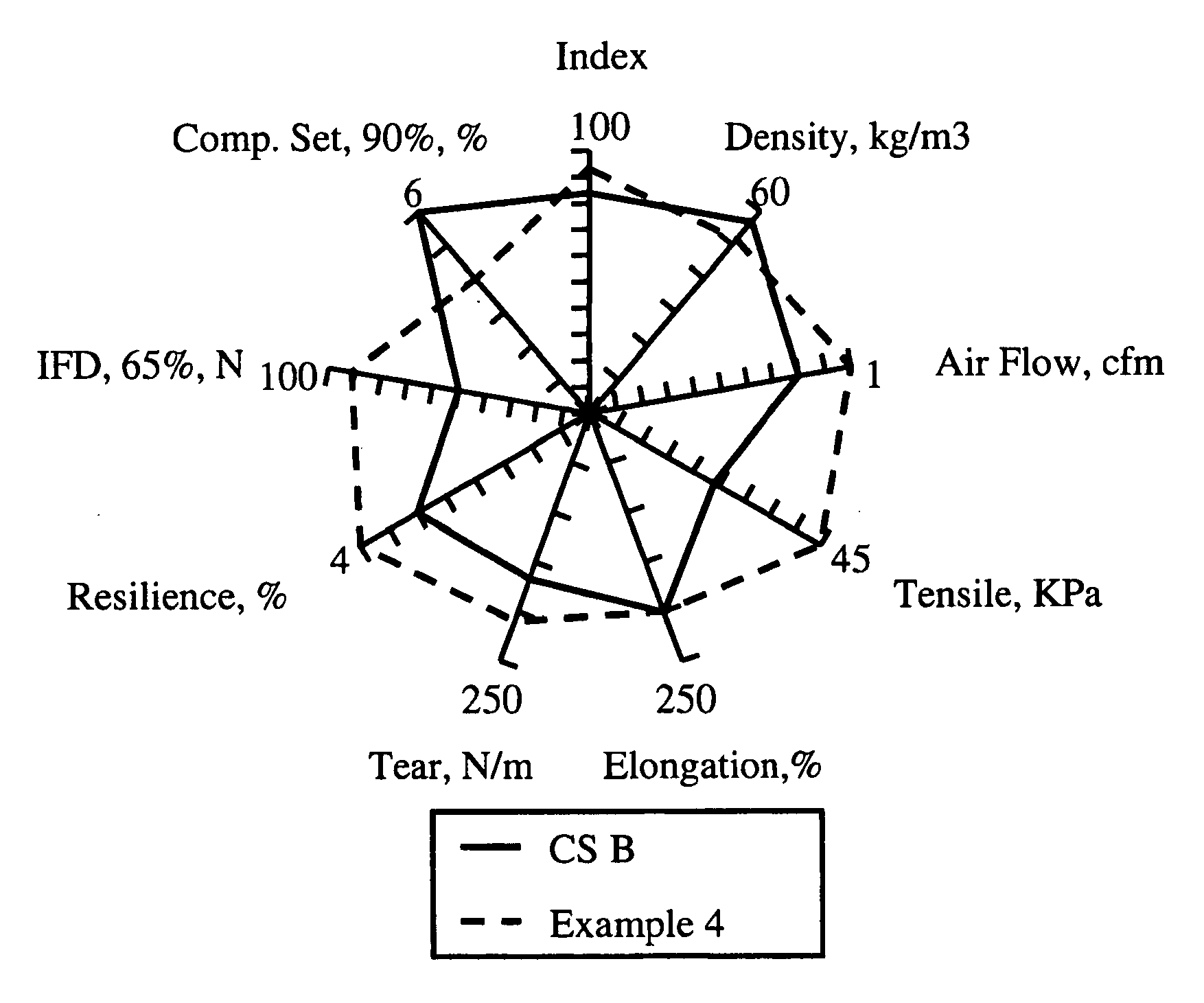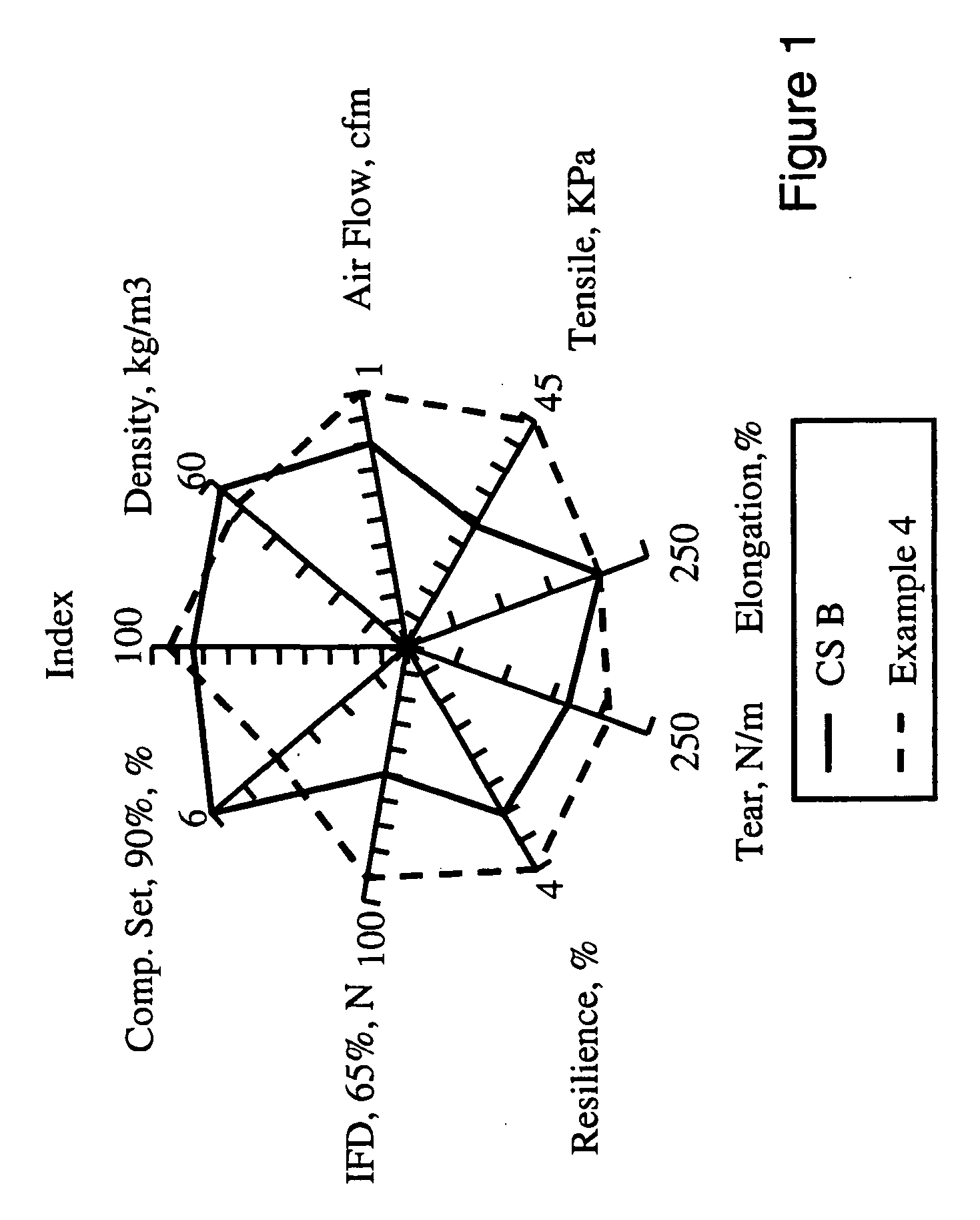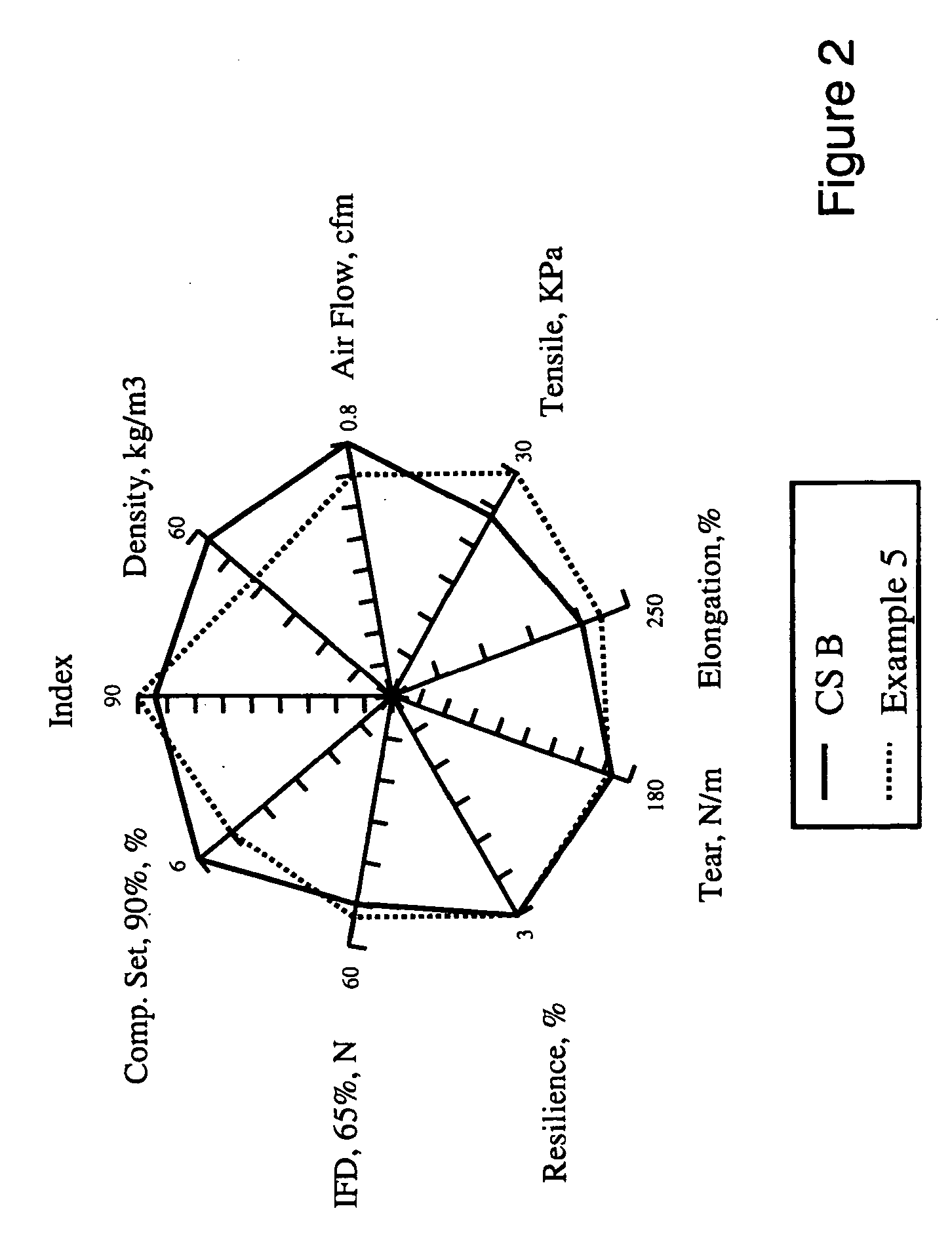Viscoelastic foams having high air flow
a viscoelastic foam and high air flow technology, applied in the field of polyurethane foams, can solve the problems of poor heat and moisture conduction out of the foam, increased foam (bed) temperature and (2) moisture level, and accelerated foam fatigue (bed), so as to achieve the effect of increasing the support factor and sacrificing the viscoelastic properties
- Summary
- Abstract
- Description
- Claims
- Application Information
AI Technical Summary
Problems solved by technology
Method used
Image
Examples
examples
[0076]The following materials are used in making foams of the invention:[0077]PEPO-1 is a 3 functional, 336 equivalent weight 100% percent propylene oxide polyether polyol commercially available from The Dow Chemical Company under the trade designation Voranol 3150 polyol;[0078]PEPO-2 is a 6.9 functional, 1800 equivalent weight random copolymer of propylene oxide and ethylene oxide commercially available from The Dow Chemical Company under the trade designation Voranol 4053 polyol;[0079]PEPO-3 is a 3 functional, 1030 equivalent weight polyether polyol containing 43% by weight of a copolymer of styrene and acrylonitrile commercially available from The Dow Chemical Company under the trade designation Voranol 3943 polyol[0080]PEPO-4 is a 3.08 functional polyol with an hydroxyl number of 153-171 mg KOH / g polyol commercially available from The Dow Chemical Company under the trade designation DWK 4066.01 polyol;[0081]NOPO-1 is a 3-functional natural oil polyol prepared from using fatty ac...
examples 1-8
and Comparative Samples A and B
[0099]Examples 1-8 and Comparative Samples A and B are prepared according to “Process A” using the materials indicated in Table 1.
TABLE 1Examples 1-8 and Comparative Samples A and BCS ACS BEX 1EX 2EX 3EX 4EX 5EX 6EX 7EX 8PEPO-195954545454543454545PEPO-25555557555NOPO-1005050505050505050Water1.251.251.251.251.351.351.351.351.351.35MOD-11.11.111111111MOD-30000.250.250.250.250.250.250.25CAT-10.150.150.180.180.180.180.180.180.180.25CAT-30.30.30.30.30.30.30.30.30.30.3CAT-40.030.030.050.050.050.050.050.030.050.03NCO-190929090909090908790(INDEX)Blow off165156150141128141150143132132Times(sec)Airflow0.1570.2970.640.590.680.630.5580.590.660.61ft3 / minAirflow4.458.4118.1216.7119.2617.8415.8016.7118.6917.27l / minAirflow0.070.140.300.280.320.300.260.280.310.29l / sDensity:4.1744.1334.2623.9583.7084.0583.7583.8243.6433.839ASTMlbm / cu_ftDensity66.86166.20468.27163.40159.39665.00360.19761.25558.35561.495Kg / m3Ball351414141513141314.2Rebound %Tensile5.98.35.95.86.35.85.75.9...
examples 13-16
[0104]Examples 13-16 are prepared according to “Process B” using the materials indicated in Table 3.
TABLE 3Examples 13-16EX 13EX 14EX 15EX 16PEPO-4——5050PEPO-14545——NOPO-150505050PEPO-255——WATER1.251.251.41MOD-2—0.20.70.6MOD-110.80.30.3CAT-2000.400.40CAT-30.300.3000CAT-10.180.180.10.1CAT-40.050.050.150.1NCO-1 / Index28 / 9028 / 9030 / 9026.7 / 90Density, kg / m359.259.649.162.4Air Flow, scfm2.21.20.80.8Air Flow l / s1.030.560.370.37Tensile Strength, KPa33323727Tensile Strength, psi4.84.65.43.9Elongation, %149145205166Tear Strength, N / m223223223191Tear Strength, lbf / in1.31.31.31.1Resilience, %181767IFD, 65%, N14713894120IFD, 65%, lbf33312127Comp. Set, 90%, %3.23.353
[0105]In Table 3, amounts are in parts per hundred part by weight of polyol except that isocyanate is listed by equivalent amounts expressed as isocyanate index. All foams are viscoelastic.
[0106]Table 3 illustrates four different formulations for the preparation of viscoelastic foams containing the natural oil derived polyol NOPO-1. Foa...
PUM
| Property | Measurement | Unit |
|---|---|---|
| weight percent | aaaaa | aaaaa |
| weight percent | aaaaa | aaaaa |
| temperature | aaaaa | aaaaa |
Abstract
Description
Claims
Application Information
 Login to View More
Login to View More - R&D
- Intellectual Property
- Life Sciences
- Materials
- Tech Scout
- Unparalleled Data Quality
- Higher Quality Content
- 60% Fewer Hallucinations
Browse by: Latest US Patents, China's latest patents, Technical Efficacy Thesaurus, Application Domain, Technology Topic, Popular Technical Reports.
© 2025 PatSnap. All rights reserved.Legal|Privacy policy|Modern Slavery Act Transparency Statement|Sitemap|About US| Contact US: help@patsnap.com



